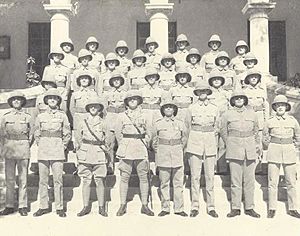Cecil Montgomery-Moore facts for kids
Major Cecil Montgomery-Moore DFC (born July 1, 1899 – died December 8, 1970) was an American-born Bermudian. He was a brave fighter pilot during the First World War. Later, he commanded the Bermuda Volunteer Engineers and the Bermuda Flying School in the Second World War.
Contents
Early Life in Bermuda
Cecil Montgomery-Moore was born in Chicopee, Massachusetts, USA, in 1899. His father was from Ireland, and his mother was from New Hampshire. In 1909, when Cecil was about 10 years old, his family moved to Bermuda. Bermuda was a British colony at that time.
Serving in the First World War
When the First World War began, Cecil wanted to help. He first joined the Bermuda Cadet Corps in 1910. Then, in 1915, he joined the Bermuda Volunteer Rifle Corps.
In 1917, Cecil was allowed to leave Bermuda to join the Royal Flying Corps (RFC). This was the British Army's air force. He was one of about twenty Bermudians who joined the air force during that war.
On April 1, 1918, the RFC joined with another air service. They formed the new Royal Air Force (RAF). Cecil became a Lieutenant in this new force. He was one of only two Bermudian airmen to earn the Distinguished Flying Cross (DFC). This award was for his bravery and skill in flying. He left the RAF in May 1919 after the war ended.
Between the World Wars
After the First World War, Montgomery-Moore returned to Bermuda. In 1931, a new local military unit was formed. It was called the Bermuda Volunteer Engineers (BVE). This unit replaced a British Army engineering group.
The BVE's first job was to operate searchlights. These searchlights helped protect Bermuda's coast. They worked with the Bermuda Militia Artillery (BMA), who operated the big guns. Later, the BVE also handled communications for the military.
Cecil Montgomery-Moore joined the BVE in 1931. He became the second-in-command. In 1932, he took over as the commander of the BVE.
Leading in the Second World War
When the Second World War started, the BVE was called into active service. They continued their important work for Bermuda's defense. Some BVE members even went overseas to fight. For example, Captain Richard Gorham earned a DFC in Italy.
In 1940, Montgomery-Moore was promoted to Major. Besides leading the BVE, he also headed the Bermuda Flying School. This school trained 80 local volunteers to become pilots. These pilots then joined the RAF or the Fleet Air Arm.
After 1942, the RAF had many trained pilots. So, the Bermuda Flying School changed its role. It became the Bermuda Flying Committee. This committee helped recruit people for the Royal Canadian Air Force. They sent sixty aircrew trainees to Canada. They also sent twenty-two women to train for ground jobs. Montgomery-Moore helped arrange these efforts. He received a special thank you from the Royal Canadian Air Force for his work.
After the War
The Bermuda Volunteer Engineers was sent home from service in 1946. Unlike some other units, the BVE was completely disbanded. Its main jobs were no longer needed.
Montgomery-Moore left military service on January 25, 1946. He returned to civilian life. He eventually settled in Connecticut, USA, where he passed away in 1970. His memories were later published in a book called That's My Bloody Plane. His wife, Hélène, later created a scholarship at Columbia University in his memory.


